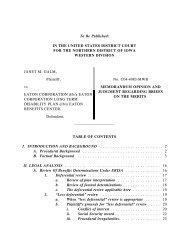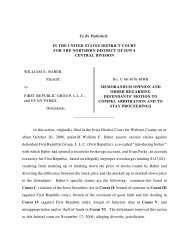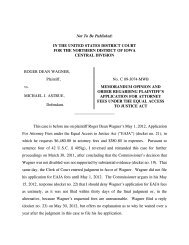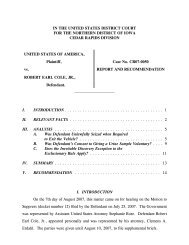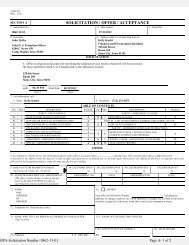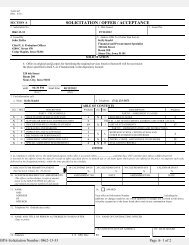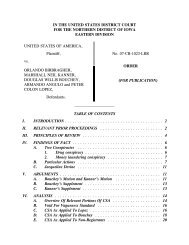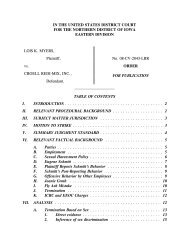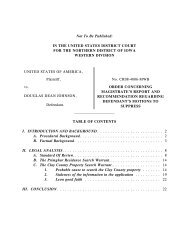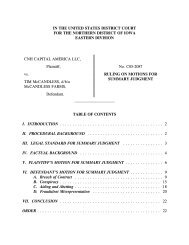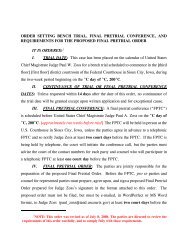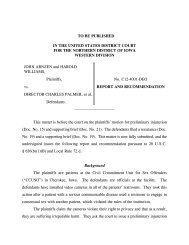Shannon v. Koehler - Northern District of Iowa
Shannon v. Koehler - Northern District of Iowa
Shannon v. Koehler - Northern District of Iowa
You also want an ePaper? Increase the reach of your titles
YUMPU automatically turns print PDFs into web optimized ePapers that Google loves.
Judge McCormick’s combined ruling on the public intoxication and interference with<br />
<strong>of</strong>ficial acts charges is defendants’ Exhibit 1012. 9<br />
Although this matter comes before me on the defendants’ motion to exclude<br />
<strong>Shannon</strong>’s acquittal for assault <strong>of</strong> a peace <strong>of</strong>ficer, I find that, before I can answer whether<br />
<strong>Shannon</strong>’s acquittals are admissible, the first question I must consider is whether<br />
<strong>Shannon</strong>’s criminal charges and interference with <strong>of</strong>ficial acts conviction are admissible.<br />
If the charges and <strong>Shannon</strong>’s conviction are inadmissible, then <strong>Shannon</strong> does not intend<br />
to introduce evidence <strong>of</strong> his acquittals, and the defendants’ motion may be granted by<br />
agreement. However, if <strong>Shannon</strong>’s conviction and charges are admissible, then I must also<br />
consider whether his acquittals are admissible.<br />
To begin, I note that I must view the question <strong>of</strong> relevance in this case through the<br />
lens <strong>of</strong> the Fourth Amendment reasonableness standard, which governs claims for<br />
excessive force. See Graham v. Connor, 490 U.S. 386, 395 (1989). Reasonableness “is<br />
viewed from the vantage point <strong>of</strong> the police <strong>of</strong>ficer at the time <strong>of</strong> arrest or seizure.” Gill<br />
v. Maciejewski, 546 F.3d 557, 562 (8th Cir. 2008) (citing Wertish v. Krueger, 433 F.3d<br />
1062, 1066 (8th Cir. 2006)); Billingsley v. City <strong>of</strong> Omaha, 277 F.3d 990, 993 (8th Cir.<br />
2002) (“The aforementioned reasonableness <strong>of</strong> force is judged from the perspective <strong>of</strong> the<br />
<strong>of</strong>ficer on the scene, taking into consideration the facts known to him, as opposed to one<br />
possessing the illuminating power <strong>of</strong> hindsight.”) (citing Nelson v. County <strong>of</strong> Wright, 162<br />
F.3d 986, 989 (8th Cir. 1998)); Nelson, 162 F.3d at 990 (“The issue <strong>of</strong> reasonableness<br />
must be examined from the perspective <strong>of</strong> the facts known to the <strong>of</strong>ficer at the time <strong>of</strong> the<br />
9 The defendants only request that I bar evidence <strong>of</strong> <strong>Shannon</strong>’s assault <strong>of</strong> a peace<br />
<strong>of</strong>ficer acquittal. Because <strong>Shannon</strong> argues that he should be allowed to introduce evidence<br />
<strong>of</strong> both <strong>of</strong> his acquittals if I allow evidence <strong>of</strong> his criminal charges and conviction, I will<br />
address both <strong>of</strong> the acquittals together.<br />
20



